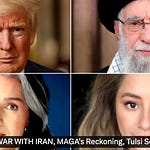My cohost
and I chat on Syria’s current crisis and outline how it’s essentially a multilayered, US-Israeli orchestrated, geopolitical plunder, mirroring Western intel’s modus operandi in the region. It’s not black and white, so it’s been rather confusing for many to understand why Israel would bomb, what’s essentially become, a US-Zionist vassal state. But there’s more to it than this binary outline which Vanessa, who is an expert in Syria and was on the ground when Damascus fell, precisely outlines in vast detail.In the most simplistic terms, recently in Suwayda, Druze factions have been at war with HTS-linked forces, as Israel unleashed massive airstrikes under the pretext of "protecting minorities. In Idlib, HTS continues executions of Alawite, Shia and other civilians while threatening further offensives—this has been ongoing since the fall of Damascus in December 2024. In Southern Damascus, Bedouin militias and Druze fighters have also been fighting. This outline contributes to the Western posturing of this as an internal Syrian crisis, brought about by Syria’s long-existing problems, which Washington and Israel must help to save Syria from, quelling the violence and bringing in democracy via “intervention,” to save the ethnic minorities. So far from the truth, but that’s what the likes of the Washington Post has put out. Israel’s Role: Framing its involvement as "security enforcement," but effectively expanding influence in southern Syria, toward its “Greater Israel Project,” backed entirely by the U.S. security state. U.S. & Turkey: Supporting proxy forces (SDF, HTS) to maintain leverage. Wahhabism is clearly used as a tool by Gulf-Zionist-Western alliances to fracture Syria along sectarian lines, and by the same vein help to isolate Iran, puncture the Axis of Resistance, and expand Abraham Accords for Greater Israel.
Syria’s conflict is not a simple “civil war” or “internal sectarian violence” caused by their own “internal divide,” but rather a proxy battleground involving regional and global powers, each pursuing their own agendas, in attempts to carve up a nice slice of the pie. The situation in Suwayda, southern Damascus, and Idlib is particularly volatile, shaped by the several key internal factions and weaponized terrorist groups, brought about by the culmination of the fall of Damascus, the ousting of Bashar al Assad, the occupation from Israel, Turkey, and Washington, and their appointment of Jolani, as the new puppet of the US-Israeli-backed Syrian totalitarian regime.
Some Key Actors & Their Roles (More discussed in video).
1. HTS (Hay’at Tahrir al-Sham)
- Backed by the U.S. intelligence networks, Turkey, and Gulf-linked factions.
- Used as a proxy, destabilizing force, then discarded when no longer useful.
- Engages in military operations and propaganda, often targeting minorities (Alawites, Shia, Druze).
shifting allegiances reflecting the directives of its foreign sponsors rather than organic strategic goals.
- Recently involved in attacks on Druze areas, triggering retaliations.
2. Druze Factions
-While the Druze community as a whole does not uniformly support Israel, certain influential figures have aligned with Israeli interests—motivated by self-preservation and political survival amid threats from extremist Salafi factions.
-Israel has strategically cultivated ties with these elements using them as buffers, using the narrative of "minority protection" to justify and expand its military and political influence in southern Syria.
-Some do not like either Jolani, HTS or Israeli forces and therefore some are currently resisting HTS incursions, leading to violent clashes.
3. SDF (Syrian Democratic Forces)
While presenting itself as a local resistance movement, the SDF remains a U.S.-backed force with strategic objectives extending beyond humanitarian aid.
Its operations in southern Syria, including the establishment of corridors toward Suwayda, suggest a broader aim of territorial consolidation.
- U.S.-backed Kurdish-led force expanding influence.
- Allegedly working to connect territories with Israeli-controlled zones, facilitating fragmentation.
4. Arab Bedouin Militias
-A significant portion of these tribal forces operate under HTS influence, whether through direct control or infiltration.
-Their role in the conflict often involves provoking sectarian violence against Druze populations, exacerbating sectarian tensions through targeted attacks.
-This cycle of retaliation serves the interests of external actors by perpetuating instability.
Once more for those who did not understand the first 100 years of Washington’s foreign policy and the Israeli project’s role in it: this conflict is a deliberately engineered war of attrition designed to keep Syria weak and fragmented, while also targeting the Resistance Axis, especially nearby Hezbollah in Lebanon, in an effort to weaken Iran. The U.S.-Israeli war path with Tehran is far from over. The so-called "humanitarian corridors" David Corridor, water corridor and sanctions are part of a broader strategy to control Syria’s resources and political future under the guise of aid and security, while securing Israel’s water resources.
Stability will not come through collaboration with occupying forces (U.S., Israel, Turkey) but through Resistance, national unity, and sovereignty—which as Vanessa outlines we may actually see some of this come to play. The continued manipulation of sectarian identities Sunni vs. Shia, Arab vs. non-Arab, ensures perpetual chaos, serving external powers at the expense of Syrian lives.
We also discuss how all of this is tied to U.S. globally provoking wars in various sectors and looking to ramp things with Russia via Ukraine, as there appears to be a shift in the way Trump has acted toward Moscow, and how Iran’s actions toward Washington and the U.S.’s aggression may have affected the Kremlin’s perception of the geopolitical Chessboard. China is also in Washington’s focus as U.S. military forces continue their drills and ramping up funds and weapons toward Taiwan.













Share this post